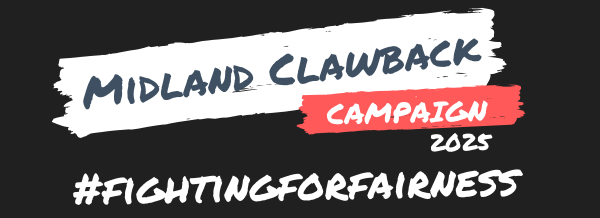
Our Story
The Midland Clawback Campaign Committee was formed to stand up for fairness in pension practices. We believe that people who spent their working lives building their pensions should not be penalised unfairly simply because of the way employer schemes were designed. Use the #fightingforfairness hashtag
What is “Clawback”?
Clawback — sometimes called “state deduction” or “state pension integration” — is a pension deduction made by an employer pension scheme when a member reaches State Pension age. The deduction is not based on your salary or pension amount, but rather on your years of service and the average State Pension at the time you leave work.
How it happened and why it’s unjust
Clawback was introduced under pensions law in 1948 to help employers offset the extra cost of the new State Pension system. In our specific case, the historic employer (then Midland Bank, now part of HSBC UK Pension Fund) introduced clawback in 1975 as a cost-saving measure.
Here’s why we believe this has resulted in unfair outcomes:
- A final salary pension scheme normally rewards you based on salary and years of service. But under clawback, the deduction uses a formula that bears no direct relation to the salary or pension you actually receive.
- Since the deduction is the same for different pension-levels, someone with a smaller pension can lose a much higher percentage of their income compared to someone with a larger pension. For example, if two people have similar service but very different salaries, the lower-paid person might lose maybe 25% of their pension, while the higher-paid person loses only 2.5%.
- The deduction scheme was applied without clear notice in staff handbooks in the 1970s/80s, which causes confusion for members who may not have fully understood the terms.
Why are we campaigning?
Because we believe this is not fair. The employer has previously admitted that clawback was introduced to save costs.
Despite the pension fund showing a surplus of over £2.5 billion at one point, and the wider company making strong profits, clawback remains in force.
The employer has stated it cannot change one section of the pension scheme without changing them all — yet this specific clawback deduction continues to affect only a subset of single scheme members.
As a campaign, we therefore press for:
- Transparent explanation of how clawback operates.
- Fair treatment of all scheme members, regardless of salary level.
- Removal or reform of the clawback deduction so that it aligns with the principle of fairness.
Legal and Government Background
- The legal device of state pension integration (clawback) was introduced alongside the State Pension in the 1948 National Insurance Act.
- Research shows that many final salary pension schemes did not include clawback — for example, surveys in 2002 / 2005 found that 60-70% of schemes made no clawback deduction.
- In November 2017, the then-Pensions Minister confirmed that the clawback arrangements were set in scheme rules and that it was the responsibility of the employer (and workforce) to decide whether to change them.
What You Can Do to Support
- Stay informed: follow our updates and media work and share with others who may be similarly affected.
- Contact your representative: write to your MP and let them know how clawback has affected you, and ask why this deduction remains in place.
- Join our campaign: by joining the Committee or supporting it, you help build the case for change.






